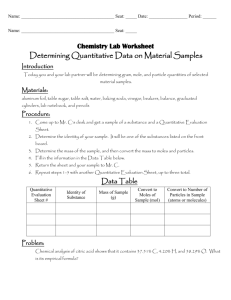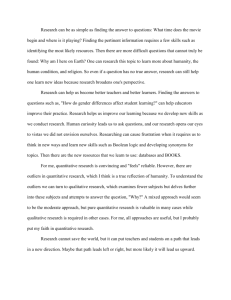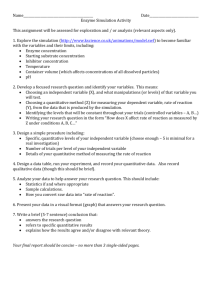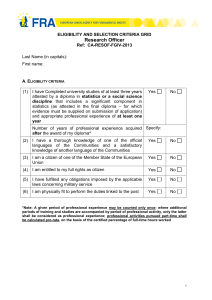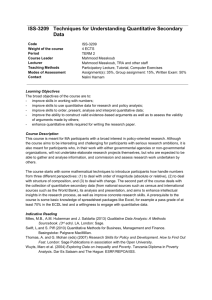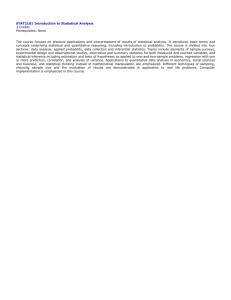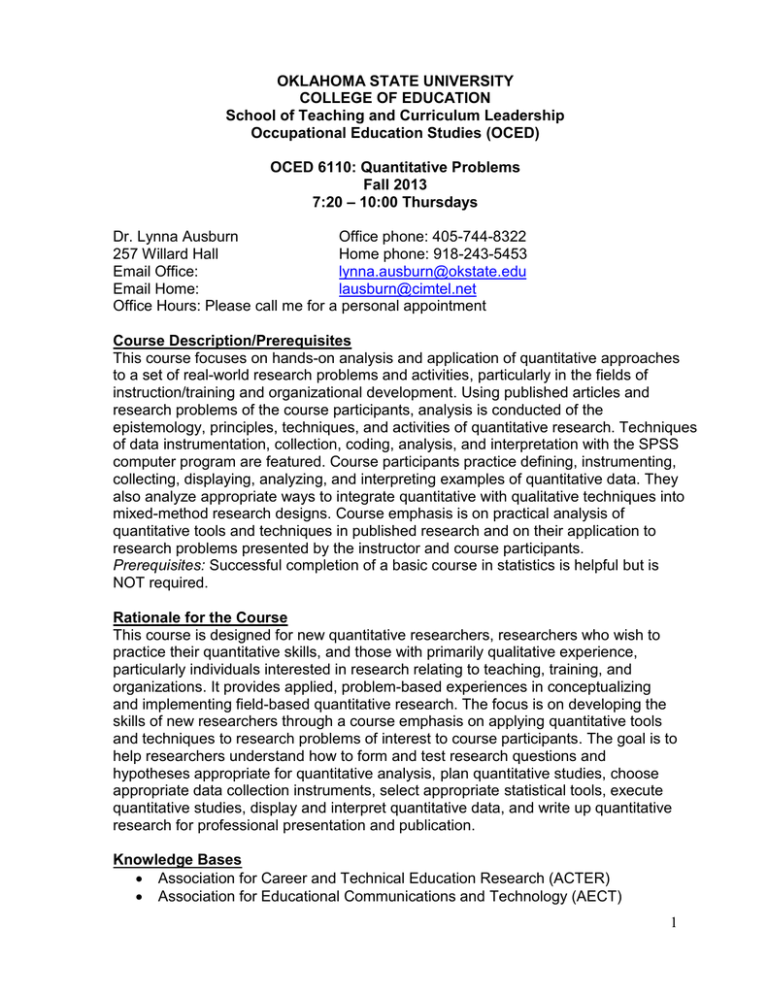
OKLAHOMA STATE UNIVERSITY
COLLEGE OF EDUCATION
School of Teaching and Curriculum Leadership
Occupational Education Studies (OCED)
OCED 6110: Quantitative Problems
Fall 2013
7:20 – 10:00 Thursdays
Dr. Lynna Ausburn
Office phone: 405-744-8322
257 Willard Hall
Home phone: 918-243-5453
Email Office:
lynna.ausburn@okstate.edu
Email Home:
lausburn@cimtel.net
Office Hours: Please call me for a personal appointment
Course Description/Prerequisites
This course focuses on hands-on analysis and application of quantitative approaches
to a set of real-world research problems and activities, particularly in the fields of
instruction/training and organizational development. Using published articles and
research problems of the course participants, analysis is conducted of the
epistemology, principles, techniques, and activities of quantitative research. Techniques
of data instrumentation, collection, coding, analysis, and interpretation with the SPSS
computer program are featured. Course participants practice defining, instrumenting,
collecting, displaying, analyzing, and interpreting examples of quantitative data. They
also analyze appropriate ways to integrate quantitative with qualitative techniques into
mixed-method research designs. Course emphasis is on practical analysis of
quantitative tools and techniques in published research and on their application to
research problems presented by the instructor and course participants.
Prerequisites: Successful completion of a basic course in statistics is helpful but is
NOT required.
Rationale for the Course
This course is designed for new quantitative researchers, researchers who wish to
practice their quantitative skills, and those with primarily qualitative experience,
particularly individuals interested in research relating to teaching, training, and
organizations. It provides applied, problem-based experiences in conceptualizing
and implementing field-based quantitative research. The focus is on developing the
skills of new researchers through a course emphasis on applying quantitative tools
and techniques to research problems of interest to course participants. The goal is to
help researchers understand how to form and test research questions and
hypotheses appropriate for quantitative analysis, plan quantitative studies, choose
appropriate data collection instruments, select appropriate statistical tools, execute
quantitative studies, display and interpret quantitative data, and write up quantitative
research for professional presentation and publication.
Knowledge Bases
Association for Career and Technical Education Research (ACTER)
Association for Educational Communications and Technology (AECT)
1
American Educational Research Association (AERA)
American Psychological Association (APA)
University Council for Workforce and Human Resource Education
Academy for Human Resource Development
Course Objectives and Student Outcomes
In successfully completing this course, participants will:
Analyze the underlying epistemology of quantitative research and differentiate
it from qualitative research.
Analyze the basic principles and concepts of quantitative research (population
and sample, internal and external validity, instrument validity and reliability,
descriptive vs. inferential statistics, statistical significance vs. practical
importance, etc.) and apply them to actual research problems and projects.
Analyze, evaluate, and interpret quantitative techniques in published
research.
Recognize and write quantitative research questions and hypotheses.
Identify the purposes of various statistical tools and select appropriate
statistical tools for quantitative research problems.
Describe data sets with descriptive statistics.
Present quantitative data graphically in tables and figures.
Analyze group comparisons using descriptive and inferential statistics.
Identify and compare sampling techniques for quantitative studies.
Analyze assumptions, limitations, and delimitations of quantitative studies.
Analyze techniques of collecting quantitative data and participate in hands-on
data collection exercises.
Code data for entry into the SPSS data analysis program and develop data
coding forms
Use SPSS for data analysis.
Interpret SPSS data analysis output.
Analyze and practice writing quantitative reports using APA guidelines.
Plan a simple quantitative study of personal interest.
Analyze the research plans of classmates.
ATTENDANCE: Each course participant will be responsible for attending class
meetings and turning in required assignments in a timely manner. You should never
miss a class without discussing your needs and options with Dr. Ausburn. It is
recognized that working adults sometimes have emergencies, and plans can be
made for these emergencies.
NOTE: You are also expected to be well prepared for each class meeting and to
participate actively in all assigned class activities.
University Policies
Dropping or Withdrawing from Classes: See the most recent OSU catalog. Be
sure you understand the difference between these two actions.
2
Notice to Students with Special Needs: If you need a special accommodation,
please advise Dr. Ausburn of the desired accommodation at some point before,
during, or after the first class meeting.
Academic Dishonesty: OSU’s policy appears in part below. (Policy & Procedures
2-0822.1). 1.01—Academic dishonesty is not condoned or tolerated at Oklahoma
State University 1.02—Academic dishonesty is behavior in which a deliberately
fraudulent misrepresentation is employed in an attempt to gain undeserved
intellectual credit, either for oneself or for another. It includes, but is not necessarily
limited to the following: plagiarism, unauthorized collaboration on out-of-class
projects, cheating on class exams, unauthorized advance access to an exam,
fraudulent alterations of academic materials, knowingly cooperating with another
person in an academically dishonest undertaking.
All forms of academic dishonesty and misconduct are considered very serious by
Oklahoma State University and the OCED program. Please note that poor
understanding of citation and referencing format and style can give the appearance
of deliberate academic dishonesty, so it is in your interest to thoroughly understand
and carefully follow all APA referencing requirements in all assignments! To avoid
grading penalties and protect yourself against misunderstood “academic stupidity,”
you are strongly urged to purchase a personal copy of the APA Publication Manual,
learn it thoroughly, and use it accurately on all written assignments in ALL courses!
Model/Style of Instruction
Various instructional strategies are used in this course. A large part of the
course is guided analytical class discussions and interactive learning activities.
Other strategies may include small group discussion and exercises, student
presentations, and individual and small-group research activities. Emphasis is on
active and participative learning; the class will learn together, collaborate with each
other, and assist each other in mastering quantitative concepts and techniques. The
classroom atmosphere is cooperative rather than competitive; the goal is
competency for all students, not competition.
Course Requirements and Expectations
Attend all classes and participate fully
Complete assigned readings and activities prior to class discussions
Complete and submit all assignments by the designated due dates
Participate in assigned learning activities
Texts and Supplementary Materials
Readings will include the required textbooks listed below, plus Internet resources,
handouts, research articles, and other resources as assigned by Dr. Ausburn.
Textbooks (REQUIRED)
3
1. Green, S.B., & Salkind, N.J. Using SPSS for windows and macintosh: Analyzing
and understanding data. Upper Saddle River, NJ: Pearson/Prentice Hall.
EITHER 5th or 6th edition is fine.
2. Salkind, N.J. Statistics for people who (think they) hate statistics. Thousand Oaks,
CA: Sage Publications. EITHER 5th or 6th edition if fine.
SPSS Statistical Analysis Computer Software
There are several options for obtaining this software to meet course assignment
requirements. We will discuss options in class, and course participants can choose
the one that best meets their needs.
Journal Articles for Analysis
These will be selected and assigned by Dr. Ausburn
Assessment and Grading
The following points will be available for various assignments and activities:
Class attendance, preparation, and participation
Assigned analysis and practice activities and exercises
Final Exam (hands-on, in-class, team-based)
Planning and presenting an individual quantitative research project
for class analysis
10 points
35 points
25 points
30 points
Total 100 points
90-100 points
80-89 points
70-79 points
60-69 points
59 and below
=A
=B
=C
=D
=F
NOTE: Grades tend to be high in this class. The emphasis is on cooperative work
between instructor and students, and among students. The goals are understanding,
skill building, and competence by all students so they can successfully meet their
research needs. As class participants develop new research understandings, skills,
and applications, they are encouraged to share with their classmates. The emphasis
is on learning together.
4

